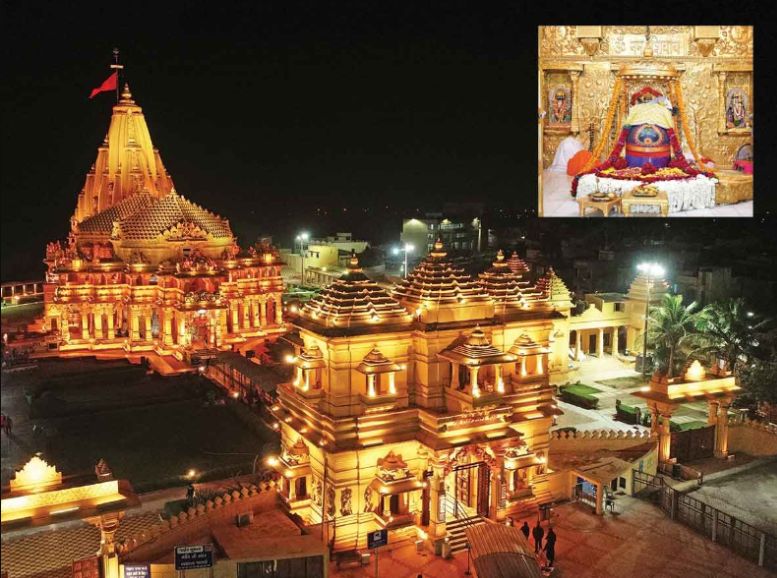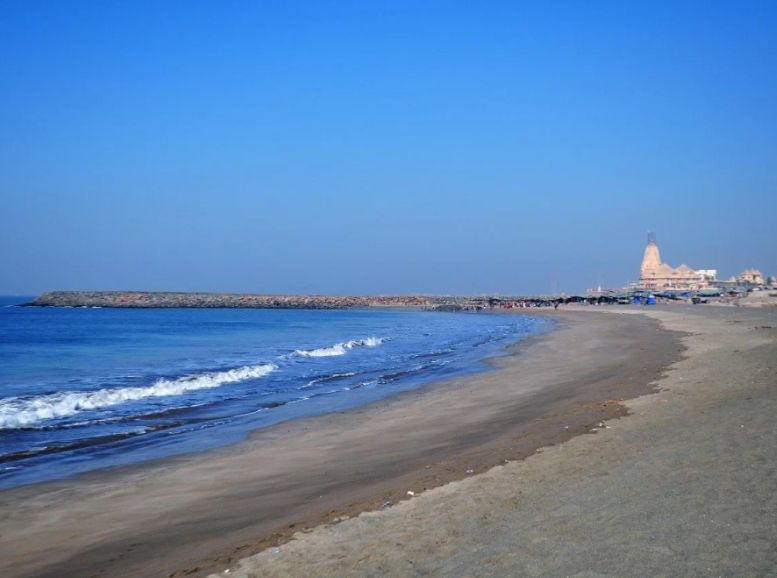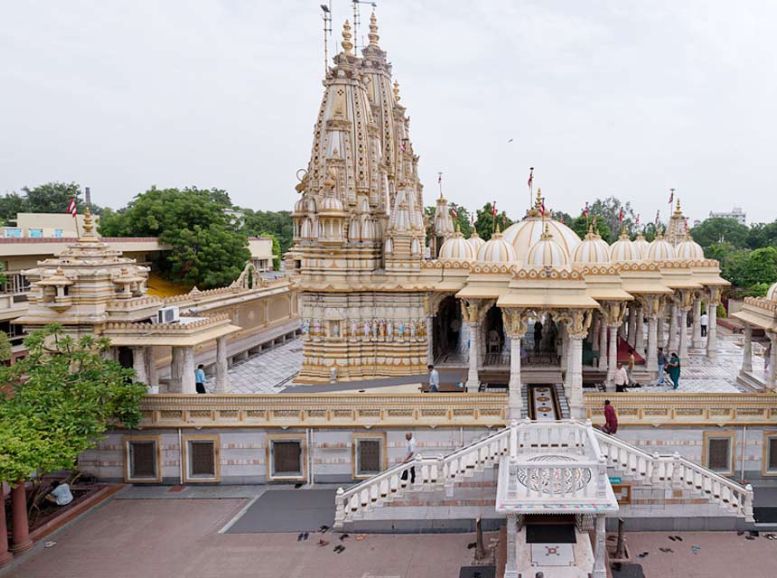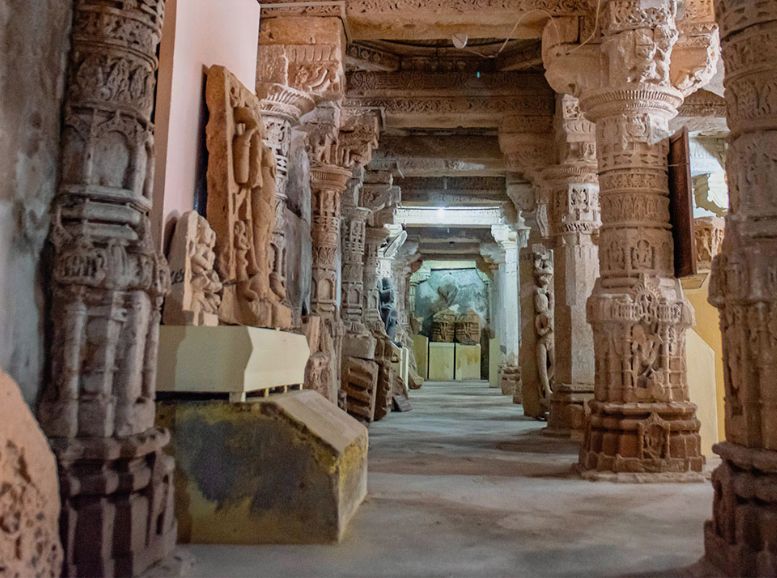Where the Arabian Sea meets Gujarat’s coast, the Somnath Temple reigns supreme. Revered as one of Hinduism’s holiest sites, this majestic structure is a Jyotirlinga, a sacred representation of Lord Shiva’s light. Its history stretches back millennia, with whispers of its existence even in the epic Mahabharata. Somnath Temple transcends a place of worship; it’s a living testament to unwavering faith and resilience, having weathered countless invasions and reconstructions throughout its storied past. Today, it stands as a beacon of cultural heritage and architectural wonder, drawing pilgrims and curious explorers alike to its sacred grounds.
How to reach:
Taking Flight: The closest airport is Diu Airport (DIU), 85 kilometers away. Regular flights connect Diu to major cities like Mumbai and Ahmedabad. Taxis or public transport can whisk you to Somnath in 2-3 hours from the airport.
Train Travel: Veraval Railway Station (VRL) is the nearest railhead, just 6 kilometers from Somnath Temple. Veraval boasts excellent connectivity to Ahmedabad, Mumbai, Delhi, and Jaipur. A short 15-20 minute taxi, auto-rickshaw, or bus ride from Veraval Station delivers you to the temple.
Road Trip: Somnath is well-connected by road to major cities and towns in Gujarat and neighboring states. Gujarat State Road Transport Corporation (GSRTC) and private buses run regularly between cities like Ahmedabad, Rajkot, Junagadh, and Veraval, all leading to Somnath. The NH51 highway also makes the temple town accessible by private cars and taxis.
Best time to visit:
Pleasant Escape (October to February): Winter reigns supreme for comfortable exploration. Temperatures range from pleasantly cool to mildly warm, making sightseeing a delight. October and November, following the monsoon, boast lush greenery and refreshing air – perfect for those seeking spiritual solace or cultural immersion without the summer heat.
Festivals and Fervor (Shravan Month & Maha Shivaratri): Witness Somnath Temple come alive during Shravan month (July-August) and Maha Shivaratri (usually February-March). Shravan is an auspicious period for Lord Shiva worship, attracting many pilgrims. Maha Shivaratri draws thousands for prayers and special rituals, with the temple adorned in vibrant lights and decorations, creating a truly charged atmosphere.
Summer Considerations (March to June): Somnath’s summer can be hot and humid, with scorching daytime temperatures. If a summer visit is unavoidable, pack sun protection and stay hydrated. Early mornings and evenings offer some respite for temple visits. However, the milder winter months generally provide a more enjoyable experience.
Attractions:
Somnath Temple:

Somnath Temple, a beacon of Hinduism, stands proudly as one of the twelve Jyotirlingas – sacred representations of Lord Shiva’s light. This architectural marvel transcends mere structure; it’s a testament to timeless devotion. The main temple complex is a masterpiece crafted in the Chalukya style, adorned with intricate carvings and sculptures that whisper tales of ancient mythology. Within the sanctum sanctorum lies the revered lingam, a symbolic representation of the cosmic pillar of light. Pilgrims and visitors alike flock here to bask in the temple’s divine aura and participate in age-old rituals, forging a connection with the enduring spiritual essence of Lord Shiva.
Somnath Beach:

Somnath Beach, a stone’s throw from the temple, provides a tranquil escape against the rhythmic roar of the Arabian Sea. Golden sands stretch along the coastline, beckoning visitors to unwind and soak in the ocean’s vastness. Witness the magic of sunset at Somnath Beach, where the sky ignites in a fiery palette of orange and crimson as the sun dips below the horizon. This idyllic spot is perfect for leisurely strolls, memorable picnics, or simply capturing the essence of the ancient temple meeting the boundless sea.
Nearby Attractions:
Laxminarayan Temple:

The Laxminarayan Temple stands as a jewel in Gujarat, captivating visitors with its artistic finesse and spiritual aura. Dedicated to the divine duo of Lakshmi, the goddess of prosperity, and Lord Vishnu (often called Narayan), the temple is a masterpiece. Intricate carvings and vibrant embellishments adorn its facade, showcasing the rich heritage of Gujarat. Inside the sanctum, the rhythmic chants and prayers of devotees create a powerful atmosphere of reverence and devotion. Whether seeking a peaceful retreat for spiritual contemplation or a captivating exploration of culture, the Laxminarayan Temple offers a sanctuary for all.
Prabhas Patan Museum:

The Prabhas Patan Museum unlocks the vibrant past of Somnath and its surroundings. Here, a fascinating collection of artifacts and sculptures acts as a historical narrative. Ancient relics, archaeological finds, and sculptures from various eras stand on display, offering a glimpse into the region’s artistic and cultural evolution. Intricate artworks, statues of deities, and artifacts unearthed from nearby sites bring Somnath’s glorious past to life, solidifying its importance in the larger story of India.
Local Experiences:
- Evening Aarti: Witness the soul-stirring evening aarti at Somnath Temple. Devotional hymns and rhythmic chants create a deeply spiritual atmosphere as the illuminated temple stands tall against the darkening sky.
- Market Magic: Wander through bustling markets overflowing with traditional handicrafts, souvenirs, religious artifacts, and local textiles. Interact with vendors and artisans to gain an appreciation for the region’s rich cultural heritage.
- Camel Caravan: Enjoy a leisurely camel ride on Somnath Beach, soaking in the scenic beauty and interacting with friendly camel owners.
- Village Vignettes: Explore nearby villages to experience rural charm and traditional lifestyles. Witness firsthand the art of traditional crafts, farming practices, and savor a taste of authentic Gujarati cuisine.
- Cultural Capers: Catch local cultural performances like folk dances, music, and traditional theater. Witness the vibrant spirit and artistic talent of the region through electrifying Garba or Dandiya Raas performances.
- Gujarati Gastronomy: Embark on a culinary adventure with local eateries. Savor dishes like dhokla, thepla, undhiyu, fafda, khandvi, and sweet treats like jalebi and basundi.
Travel tips:
- Knowledge is Power: Delve into the temple’s history, timings, and rituals before your visit. This knowledge will help you make the most of your experience.
- Weather Wisdom: Consider the seasons. October to February boasts pleasant weather, ideal for sightseeing.
- Respectful Attire: Opt for modest clothing that adheres to temple etiquette. Avoid sleeveless tops, shorts, and revealing outfits.
- Barefoot Essentials: Be prepared to remove your shoes before entering the temple. Bring a bag for them if needed.
- Sun Smarts: Pack sunscreen, hats, and sunglasses, especially during the hotter months.
- Hydration Hero: Carry a reusable water bottle to stay hydrated, particularly when exploring outdoors.
- Safeguard Your Belongings: Keep your valuables secure and be aware of pickpockets, especially in crowded areas.
- Local Assistance: Seek help from authorized personnel or information centers if you need assistance or guidance.
- Temple Etiquette: Follow temple rules; maintain silence, avoid touching idols, and respect the sanctity of the place.
- Camera Courtesy: Check photography policies at the temple and other attractions. Some areas may restrict photography.
Conclusion
Somnath Temple transcends a pilgrimage; it’s a captivating tapestry woven with history, culture, and spirituality. Bathed in the serenity of the Arabian Sea, this sacred site offers an immersive experience into the divine legacy of Lord Shiva. Witness the awe-inspiring evening aarti, or get lost in the intricate architecture – Somnath Temple leaves an indelible mark on every visitor. But the magic extends beyond the temple walls. Explore the serenity of Somnath Beach, delve into history at the Junagadh Gate, or immerse yourself in the rich traditions of nearby villages. Each adds a unique thread to your experience, showcasing the region’s vibrant spirit and natural beauty. Plan your Somnath adventure with Xplro.com.
FAQs
When is the ideal time to visit Somnath Temple?
- The most favorable time to visit Somnath Temple is during the winter months from October to February, when the weather is pleasant and ideal for sightseeing. Visiting during festivals like Maha Shivaratri also offers a unique cultural experience.
What are the transportation options to reach Somnath Temple?
- Somnath Temple is accessible by road, rail, and air. The closest airport is Diu Airport, about 85 km away. The nearest railway station is Veraval, approximately 7 km from Somnath. There are regular buses and taxis available from major cities in Gujarat to Somnath.
What are the operating hours of Somnath Temple?
- The temple is open daily from 6:00 AM to 9:00 PM. The evening aarti, a highlight for visitors, takes place at 7:00 PM.
Is photography permitted inside Somnath Temple?
- Photography is generally prohibited inside the main temple to maintain its sanctity. However, you can take photos in the outer areas and at nearby attractions.
Is there a dress code for visitors to Somnath Temple?
- Yes, visitors should dress modestly and respectfully. Avoid sleeveless tops, shorts, and revealing clothing. Traditional or conservative attire is recommended.
What other places of interest are there near Somnath Temple?
- Nearby attractions include Somnath Beach, Gita Mandir, Laxminarayan Temple, Prabhas Patan Museum, Triveni Sangam, Bhalka Tirth, Panch Pandav Gufa, and Junagadh Gate.
Are there good accommodation options near Somnath Temple?
- Yes, there are various lodging options ranging from budget hotels to luxury resorts near the temple. It’s best to book in advance, especially during peak tourist seasons and festivals.
What local dishes should I try when visiting Somnath?
- Try traditional Gujarati dishes such as dhokla, thepla, undhiyu, fafda, khandvi, and sweets like jalebi and basundi. Local eateries and restaurants offer a variety of authentic dishes.
Can visitors take part in the temple rituals and ceremonies?
- Yes, visitors are welcome to participate in temple rituals and ceremonies. The evening aarti is particularly popular. You can also offer prayers and light diyas.
Are there facilities to store shoes and belongings at the temple? A
- Yes, there are designated areas to store footwear and personal items near the temple entrance. It’s a good idea to bring a bag for your shoes.
Are there special provisions for senior citizens and differently-abled visitors?
- The temple complex is generally accessible, but it’s advisable to check for specific facilities such as wheelchairs and priority access for senior citizens and differently-abled visitors.
What safety measures should I take while visiting Somnath Temple?
- Keep your belongings secure and be aware of your surroundings in crowded areas. Stay hydrated, use sun protection, and follow local guidelines and temple rules to ensure a safe and enjoyable visit.





